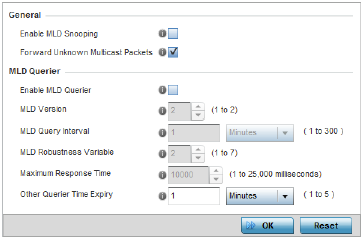MLD (Multicast Listener Discovery) snooping enables a controller, service platform or access point to examine MLD packets and make forwarding decisions based on content. MLD is used by IPv6 devices to discover devices wanting to receive multicast packets destined for specific multicast addresses. MLD uses multicast listener queries and multicast listener reports to identify which multicast addresses have listeners and join multicast groups.
MLD snooping caps the flooding of IPv6 multicast traffic on controller, service platform or access point VLANs. When enabled, MLD messages are examined between hosts and multicast routers and to discern which hosts are receiving multicast group traffic. The controller, service platform or access point then forwards multicast traffic only to those interfaces connected to interested receivers instead of flooding traffic to all interfaces.
To set an IPv6 MLD snooping configuration:
The selected profile's configuration menu displays.

| Enable MLD Snooping | Enable MLD snooping to examine MLD packets and make content forwarding for this profile. Packets delivered to group members are identified by a single multicast group address. Multicast packets are delivered to a group using best-effort reliability, just like IPv6 unicast. MLD snooping is disabled by default. |
| Forward Unknown Multicast Packets | Use this option to either enable or disable IPv6 unknown multicast forwarding. This setting is enabled by default. |
| Enable MLD Querier | Select this option to enable MLD querier on the controller, service platform or access point. When enabled, the device sends query messages to discover which network devices are members of a given multicast group. This setting is disabled by default. |
| MLD Version | Define whether MLD version 1 or 2 is utilized as the MLD querier. MLD version 1 is based on IGMP version 2 for IPv4. MLD version 2 is based on IGMP version 3 for IPv4 and is fully backward compatible. IPv6 multicast uses MLD version 2. The default MLD version is 2. |
| MLD Query Interval | Set the interval in which query messages are sent to discover device multicast group memberships. Set an interval in either Seconds (1 -18,000), Minutes (1 - 300) or Hours (1 - 5). The default interval is 1 minute. |
| MLD Robustness Variable | Set a MLD IGMP robustness value (1 - 7) used by the sender of a query. The MLD robustness variable enables refinements to account for expected packet loss on a subnet. Increasing the robust count allows for more packet loss, but increases the leave latency of the subnetwork unless the value is zero. The default variable is 2. |
| Maximum Response Time | Specify the maximum response time (from 1 - 25,000 milliseconds) before sending a responding report. Queriers use MLD reports to join and leave multicast groups and receive group traffic. The default setting is 10 milliseconds. |
| Other Querier time Expiry | Specify an interval in either Seconds (60 - 300) or Minutes (1 - 5) used as a timeout interval for other querier resources. The default setting is 1 minute. |